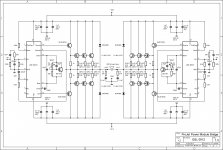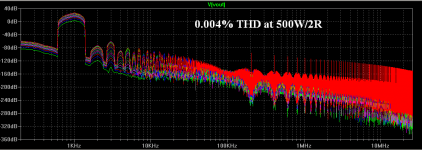I want to build a good amp for PA use. And it should be better than Peavey CS series. And it should be better than QUASI NBIP. My transistor box only has 12 pairs of MJ11015/16 darlington (Vce=120V).
My question is: is it uncommon to use darlington for PA amplifiers? Do I have a chance?
My question is: is it uncommon to use darlington for PA amplifiers? Do I have a chance?
What about something like this? Six pairs per channel, 800 Wrms/4 ohm
MUR DIODES ARE FORWARD BIASED!!!. A SHORT CIRCUITED AMP!!!
For very high power I think "ordinary" ClassAB will run too hot and/or need too much cooling.
I think one needs to look at the super power classes to help solve this "heat" problem and at the same time alleviates the temperature de-rated SOAR limitations.
Apex has shown some very high power implementations.
I think one needs to look at the super power classes to help solve this "heat" problem and at the same time alleviates the temperature de-rated SOAR limitations.
Apex has shown some very high power implementations.
My question is: is it uncommon to use darlington for PA amplifiers? Do I have a chance?
Yes, darlington power devices are uncommon in PA amps. You'll run into a lot of problems when you start to parallel them.
What about something like this? Six pairs per channel, 800 Wrms/4 ohm
Ewww... looks like a high-end amp!
I think one needs to look at the super power classes to help solve this "heat" problem and at the same time alleviates the temperature de-rated SOAR limitations.
Apex has shown some very high power implementations.
Yes, but I think they aren't darlingtons.
Yes, darlington power devices are uncommon in PA amps. You'll run into a lot of problems when you start to parallel them.
That's what I've heard. Regarding paralleling, I have built and seen professional stuffs with paralleled darlingtons (actually my darlingtons are taken out of one of these stuffs). But that's for low power amps. For PA, it is scary because users usually parallel 4 or more big speakers at the output.
Ewww... looks like a high-end amp!I will try to work on this circuit thanks.
Yeah it is just an idea to have integrated front-end in LMEs for more simplicity. Considering Vce 120Vmax for your Darlingtons, bridged amp is the only way to get some serious power output at max. +/-60 V rails potential.
Paralleling of Darlingtons can be performed if the drive current is evenly divided among all three parallel outputs and if they have app. the same hFE.
The other solution is to have separate bias setting for each Darlington pair.
But if you're determined to use Darlingtons than you'll find the proper solution too, I'm sure.

Considering Vce 120Vmax for your Darlingtons, bridged amp is the only way to get some serious power output at max. +/-60 V rails potential.
Yes, bridged amp. I will remember that.
Paralleling of Darlingtons can be performed if the drive current is evenly divided among all three parallel outputs and if they have app. the same hFE.
Just because the darlingtons were taken out of expensive device, I wish they have matched characteristics.
But if you're determined to use Darlingtons than you'll find the proper solution too, I'm sure.
Just trying to make use what I have on hands.
I just tried simulating the Darlington in dual LTP topology. It seems with low rail the distortion cannot be made low.
Tried again with Linn topology, got 0.004% THD at 500W/2R. But it is highly biased AB class (Easily oscillate in class B).
Attachments
with 0.22 ballast resistors you have very few chances ....0.22 will not be enough to ballast between the darlingtons
when it comes to darlingtons hfe will be almost the last to bother with ...Do not forget that a darlington include the driver in the package so beta is the issue there that obviously will vary with catastrophic results depending on the supply / pcb/ drive/ load/and thermals
eventhough 11015-16 if as said the quality is good is a quite rugged device the supply is kinda low for such an application and bridged mode will also suffer from a number of issues
thermal tracking is also a bad solution ( to my understanding ) since will solve hardly one of the problem
I could see a solution with may be a multislope or dedicated VI limiters but then again will not be cost worthy from any aspect .
Finally common practice says that is never done before ...that should be a starting point ..
Kind regards
sakis
when it comes to darlingtons hfe will be almost the last to bother with ...Do not forget that a darlington include the driver in the package so beta is the issue there that obviously will vary with catastrophic results depending on the supply / pcb/ drive/ load/and thermals
eventhough 11015-16 if as said the quality is good is a quite rugged device the supply is kinda low for such an application and bridged mode will also suffer from a number of issues
thermal tracking is also a bad solution ( to my understanding ) since will solve hardly one of the problem
I could see a solution with may be a multislope or dedicated VI limiters but then again will not be cost worthy from any aspect .
Finally common practice says that is never done before ...that should be a starting point ..
Kind regards
sakis
- Status
- This old topic is closed. If you want to reopen this topic, contact a moderator using the "Report Post" button.
- Home
- Amplifiers
- Solid State
- Any High Power Darlington PA Amp Please?

